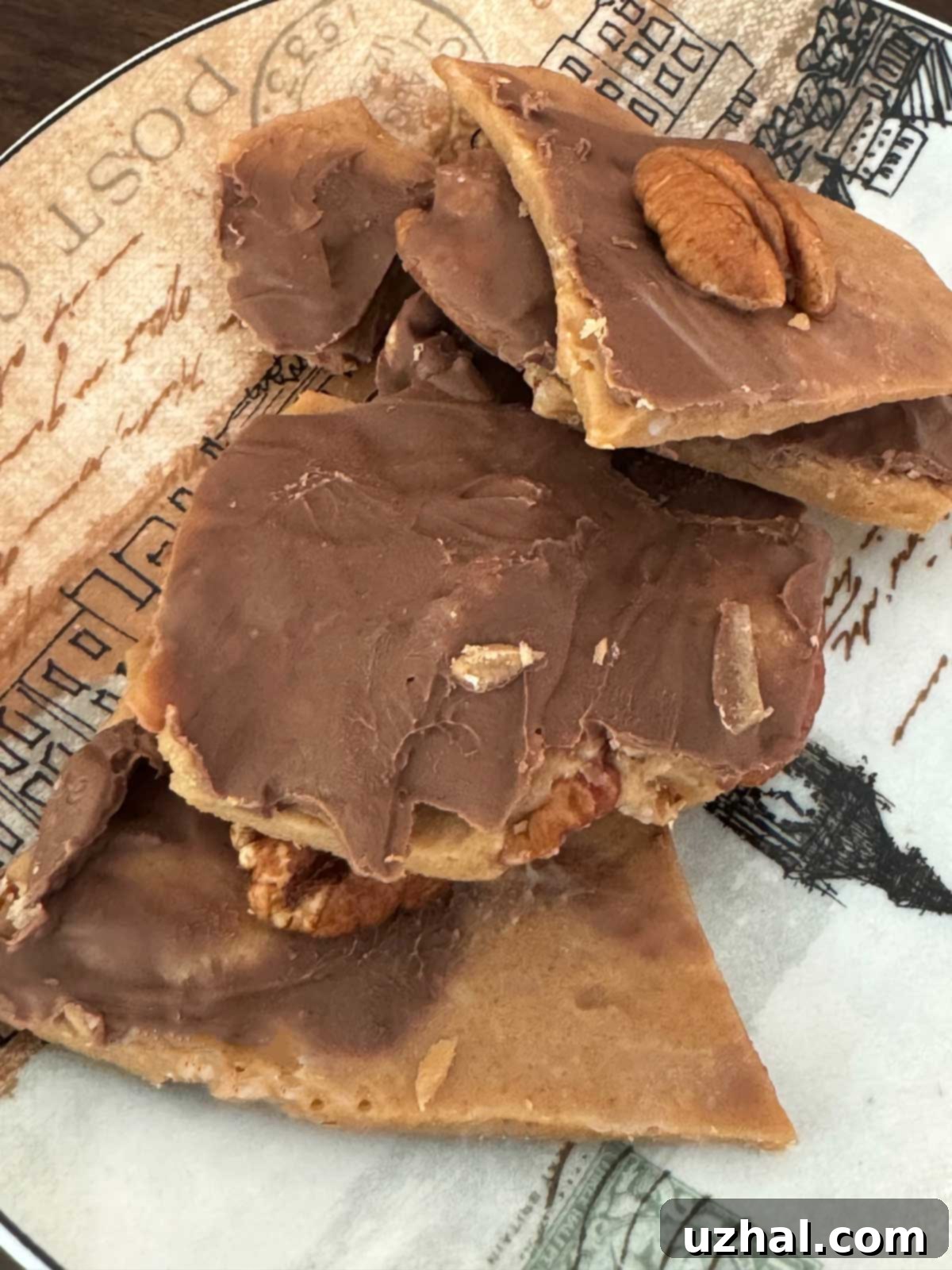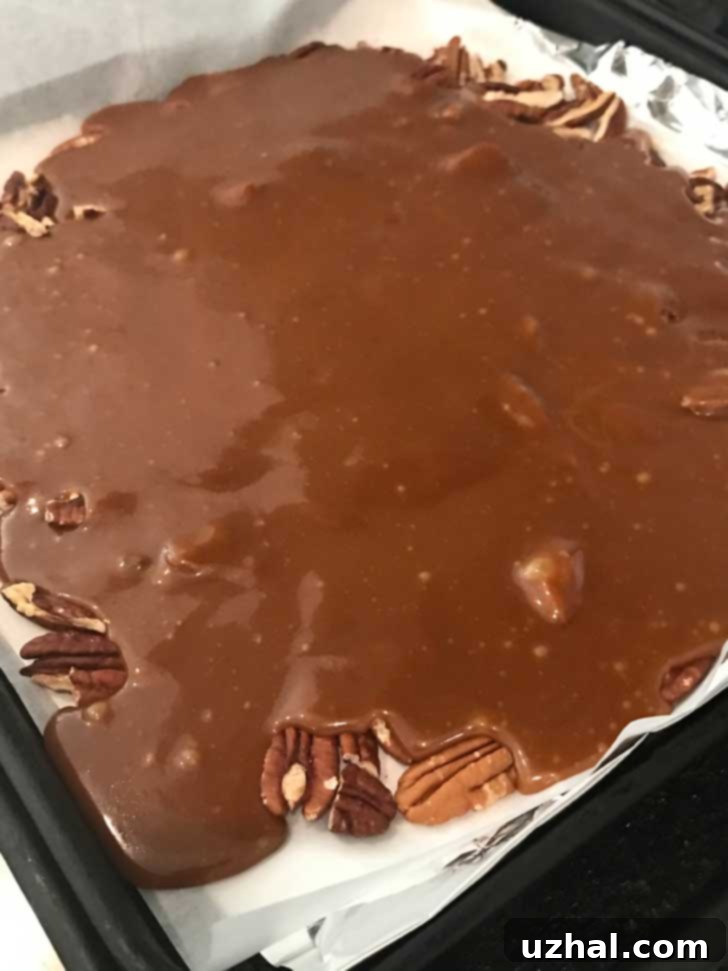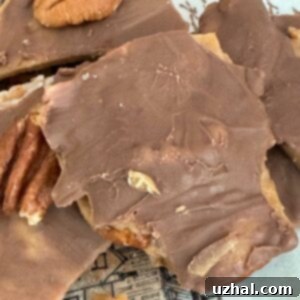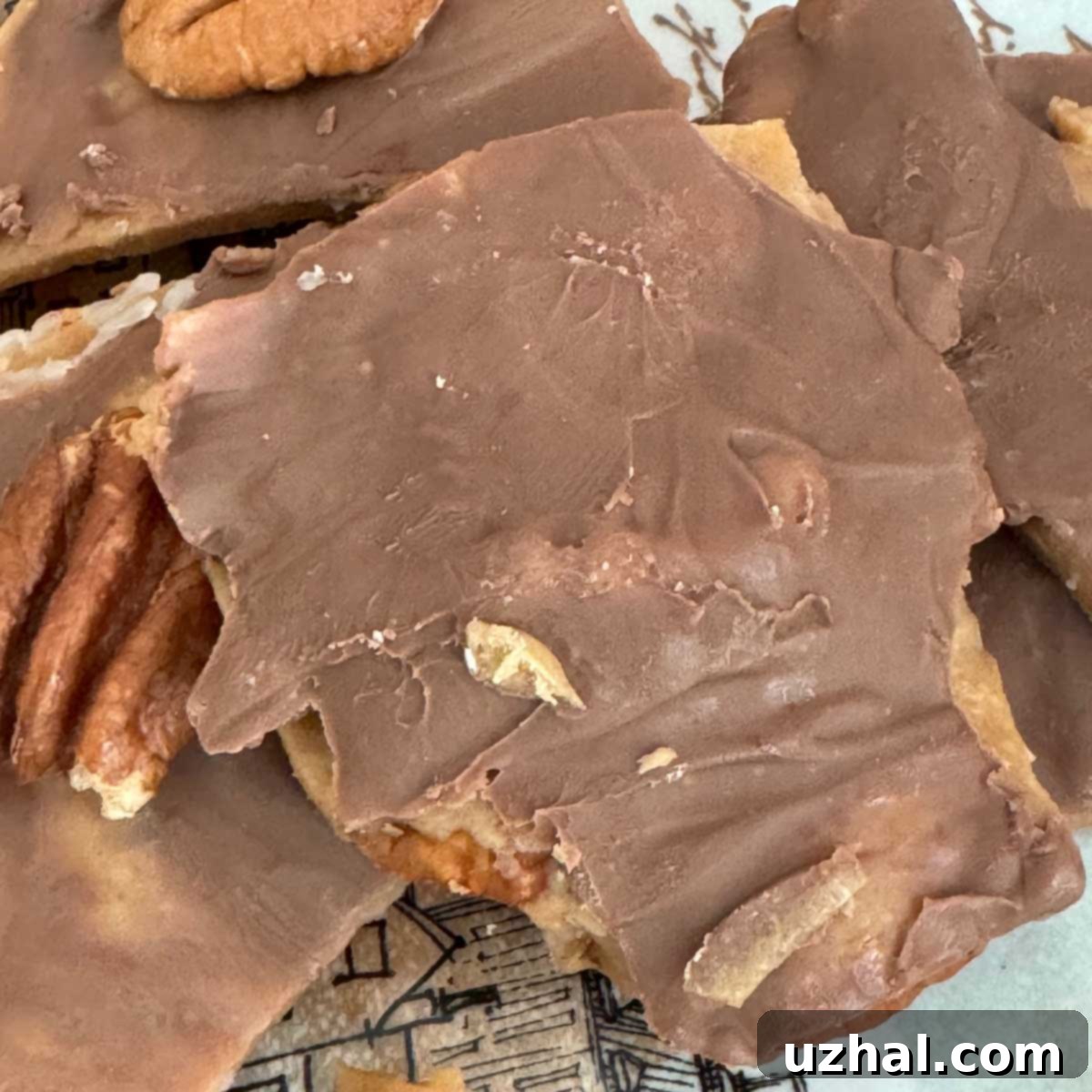The Ultimate Guide to Brown Sugar Pecan Toffee: A Delectable Homemade Treat
There’s something truly magical about homemade toffee. The crisp snap, the rich buttery flavor, and the satisfaction of creating such a delicious confection right in your own kitchen are unmatched. For years, my go-to has been a classic almond toffee, a beloved tradition. However, this year, I decided to venture into new territory, and the result is this absolutely irresistible Brown Sugar Pecan Toffee. While I’ll always cherish the almond version, this pecan variation brings a delightful depth and a subtle nuance that makes it a perfect companion to any holiday spread or a thoughtful homemade gift.
What makes this recipe so special is its elegant simplicity. Requiring just four core ingredients – pecan halves, rich brown sugar, good quality salted butter, and a generous layer of milk chocolate – it’s a surprisingly straightforward candy to master. And for those who prefer the pure essence of toffee, you can even strip it down to a mere two ingredients: salted butter and brown sugar, for a delightful, buttery bite. This guide will walk you through every step, ensuring you achieve perfect, glossy, and crunchy toffee every single time.
Jump to Recipe

The Distinctive Charm of Brown Sugar Pecan Toffee
Many traditional toffee recipes call for white granulated sugar, which results in a wonderfully crisp, classic candy. However, my journey into toffee-making recently led me to discover that the authentic British approach often involves brown sugar, good quality salted butter, and occasionally a touch of golden syrup. This particular recipe embraces that traditional spirit, foregoing the syrup but leaning heavily on the rich caramel notes that brown sugar imparts. The result is a toffee with a deeper, more complex flavor profile that hints at butterscotch, providing a sophisticated twist on a beloved treat.
Beyond the sugar, the pecans are, of course, a star of this particular creation. While the recipe is named “Brown Sugar Pecan Toffee,” it’s incredibly versatile. If you’re not a fan of nuts, or if you simply want to make plain toffee bits for baking or snacking, the pecans can be omitted entirely. I often prepare a batch without nuts to create homemade toffee pieces, perfect for adding to cookies, ice cream, or other desserts. The choice is yours, but the addition of toasted pecans provides a delightful crunch and nutty counterpoint to the sweet, buttery toffee.
Understanding Your Ingredients for Perfect Toffee
Success in toffee making largely hinges on the quality and preparation of your ingredients. This recipe is simple, but each component plays a crucial role:
- Pecan Halves (Optional but Recommended): For the best flavor and texture, always toast your pecans before incorporating them. This enhances their natural nuttiness and provides a more pronounced crunch against the smooth toffee. While optional, they truly elevate this candy.
- Salted Butter: The foundation of any great toffee. Using salted butter is key here, as the salt beautifully balances the sweetness of the sugar. If you only have unsalted butter on hand, simply add about 1 teaspoon of kosher salt to the mixture (as noted in the recipe card) to achieve that perfect flavor balance. Cut it into chunks for more even melting.
- Brown Sugar: This is where the magic happens. Brown sugar, with its molasses content, contributes a richer, more caramel-like flavor compared to white sugar. It also influences the final texture, giving the toffee a slightly chewier yet still perfectly brittle snap. Light brown sugar is typically used for a delicate caramel taste, but dark brown sugar can be used for a more intense, robust flavor.
- Good Quality Milk or Dark Chocolate (Optional): The chocolate layer is the crowning glory. While optional, it adds a luxurious finish. Opt for a high-quality chocolate, whether milk or dark, that you enjoy eating on its own. Good chocolate melts smoother and tastes infinitely better. Chopping the chocolate ensures it melts quickly and evenly when sprinkled over the hot toffee.
Mastering the Toffee Making Process: Stirring and Temperature
Making toffee is often perceived as daunting, but with a few key techniques and the right tools, it’s entirely achievable. The process involves cooking sugar and butter to a very specific temperature, known as the “hard crack stage.”
The Art of the Stir
While some candy recipes demand constant, vigorous stirring, this brown sugar pecan toffee recipe requires a more measured approach. You need to stir consistently enough to prevent the mixture from scorching on the bottom of the pan, but not so much that you introduce too many air bubbles or encourage premature crystallization. If you’re using a heavy-bottomed saucepan and your heat is under control (medium-low to medium is ideal), you can take brief pauses from stirring. However, it’s best to maintain a watchful eye and stir *almost* constantly, especially as the mixture begins to thicken and darken, which typically occurs after it passes about 240 degrees Fahrenheit. A sturdy wooden spoon is excellent for this task, allowing you to scrape the bottom and sides effectively.

Achieving the Hard Crack Stage: Your Candy Thermometer is Key
The “hard crack stage” is critical for achieving that signature brittle snap. This stage occurs when the sugar solution reaches temperatures between 300 to 310 degrees Fahrenheit (149-154 degrees Celsius). At this point, almost all the water has evaporated from the sugar mixture, and it will become very hard and brittle when cooled.
A reliable candy thermometer is not just recommended; it’s an absolute must for success. Eyeballing the temperature can lead to overly chewy (undercooked) or burnt and bitter (overcooked) toffee. My personal favorite is the Taylor deep fry thermometer. Its design is particularly helpful because it can securely lean on the pot, allowing you to position the bulb perfectly in the center of the pan without touching the bottom. This elevation is vital, as contact with the pan’s hot bottom can give an inaccurate reading. While the hard crack range is 300-310°F, I’ve found that pulling the candy from the heat right at 300°F works perfectly, ensuring a beautiful color and ideal texture without risking scorching. Pushing it to 310°F can be cutting it too close for some stovetops, leading to a darker, more intense (sometimes burnt) flavor. Always ensure you are using a heavy-duty saucepan, such as a non-stick anodized aluminum style like Green Pan or Simply Calphalon, which distributes heat evenly and minimizes burning.
Finishing with a Flawless Chocolate Layer
Once your toffee has reached its golden, hard-crack perfection, the final steps are all about bringing in the delicious chocolate and ensuring a beautiful set.
Prepping and Pouring
Unlike some recipes where nuts are stirred into the toffee, for this brown sugar pecan toffee, you pour the hot candy directly over a layer of prepared pecans (if using) spread evenly on a parchment-lined baking sheet. This ensures the nuts are beautifully encased and lightly toasted by the residual heat. Work quickly but carefully here; the toffee will begin to set as it cools.
The Chocolate Melt
Immediately after pouring the hot toffee, sprinkle the chopped milk or dark chocolate squares over its surface. The intense heat of the fresh toffee will begin to melt the chocolate. To hasten this process and create a smooth, even layer, a clever trick is to invert another rimmed baking sheet over the top of the toffee-covered sheet. This traps the heat, creating a warm, humid environment that encourages the chocolate to soften quickly to a spreadable consistency. Once softened, use an offset spatula or the back of a spoon to spread the melted chocolate evenly across the toffee. At this point, the toffee might feel slightly soft and rubbery, but it will be firm enough to support the chocolate layer.
Setting for Perfection
For the chocolate to set properly and bond with the toffee, it needs to cool. You can allow it to cool at room temperature for an hour or so, then transfer it to the refrigerator for several hours. If, like me, you find patience a virtue you sometimes lack, the freezer works wonders too! Just 30-60 minutes in the freezer can be enough to achieve a perfectly set, crisp toffee and firm chocolate layer. Once thoroughly set, the toffee can be easily broken into delicious, irregular pieces, ready for enjoying or gifting.

Tips for Toffee Success
Making candy, especially toffee, can feel intimidating, but a few simple tips will ensure your success:
- Read Through Completely: Before you even start melting butter, read the entire recipe and instructions. This helps you anticipate steps and prepare.
- Mise en Place: Have all your ingredients measured, chopped, and ready to go before you turn on the stove. Candy making moves quickly, and you won’t have time to search for an ingredient.
- Don’t Rush the Heat: Cooking over medium-low to medium heat allows the sugar to melt and cook evenly without burning. Patience is key!
- Calibrate Your Thermometer: Periodically check your candy thermometer’s accuracy by placing it in boiling water. It should read 212°F (100°C) at sea level. Adjust your target temperature accordingly if it’s off.
- Prevent Sugar Crystals: Avoid scraping down the sides of the pan with your spoon once the toffee starts boiling, as this can introduce sugar crystals back into the mixture, leading to grainy toffee. If crystals form, you can carefully brush them down with a wet pastry brush.
- Humidity Matters: High humidity can affect how quickly candy sets. On very humid days, it might take a little longer to reach the hard crack stage or to set completely.
- Clean Up Quickly: Hot sugar can be incredibly sticky and hard to clean. Fill your saucepan with water and bring it to a boil after you’ve poured out the toffee. This will dissolve any stuck-on sugar, making cleanup a breeze.
Variations and Serving Suggestions
While this Brown Sugar Pecan Toffee recipe is fantastic as is, feel free to customize it to your taste:
- Nut Alternatives: If pecans aren’t your favorite, try toasted almonds, walnuts, or even macadamia nuts.
- Chocolate Choices: Experiment with different types of chocolate. White chocolate, dark chocolate, or even a mix can be delicious. You can also drizzle melted chocolate instead of covering the entire surface.
- A Sprinkle of Salt: For a gourmet touch, sprinkle a bit of flaky sea salt (like Maldon) over the melted chocolate before it sets. The sweet and salty combination is divine.
- Spices: A pinch of cinnamon or nutmeg added with the brown sugar can add a subtle warmth to the toffee.
- Toffee Bits: Omit the nuts and chocolate entirely to make pure brown sugar toffee, perfect for crushing and using in cookies, on ice cream, or as a crunchy topping for other desserts.
Serve this delightful toffee as a sophisticated after-dinner treat, package it beautifully for holiday gifts, or simply keep a stash for yourself to enjoy with a cup of coffee or tea. Its rich flavor and satisfying crunch make it a truly versatile and beloved confection.
Good luck with the recipe! Don’t be scared off by the candy thermometer; it’s a helpful tool that ensures perfect results every time. And if you’re curious about my other favorite, here’s the link to my classic Almond Toffee if you want to try that one as well.
- Toffee Chunk Oat Cookies
- Mini Peanut Butter Chocolate Chip Toffee Cookies
- Mini Peanut Butter Cups Toffee Chunk Cookies
- Eight Giant Double Chocolate Toffee Cookies
- Coffee Toffee Chocolate Chip Cookies
Recipe

Brown Sugar Pecan Toffee
Anna
Pin Recipe
Ingredients
- 1 cup pecan halves (optional, but highly recommended for texture and flavor)
- 2 sticks salted butter, cut into chunks (228 grams; see note about unsalted butter)
- 1 cup brown sugar (210 grams)
- 4-6 ounces good quality dark or milk chocolate (optional, chopped for easier melting)
Instructions
-
If using pecans, spread them flat on a baking sheet. Bake in a preheated 350°F (175°C) oven for 8 to 10 minutes, or until they are delightfully fragrant and lightly toasted. Allow them to cool completely, then chop them lengthwise or into large, rustic chunks.
-
Line a 15×10 inch jelly roll pan (or a similar sized baking sheet with a rim) with parchment paper. This will prevent sticking and make for easy removal. Set this prepared pan next to your stove, ready for the hot toffee.
-
In a 3-quart heavy-bottomed saucepan, gently melt the salted butter over medium-low heat. Once melted, remove the pan from the heat and add the brown sugar. Stir well with a wooden spoon until the sugar is as fully blended as possible with the butter. Don’t worry if the butter appears slightly separated from the sugar at this stage; it will come together as it cooks. If desired, you can add a small pinch of kosher salt now to enhance the flavor.
-
Carefully place a deep-fry or candy thermometer into the pan, ensuring the bulb does not touch the bottom of the saucepan. Return the pan to medium-low to medium heat. Begin cooking, stirring almost constantly to prevent burning, especially once the candy mixture reaches around 240°F (115°C). The temperature should rise slowly and steadily; the entire cooking process should take approximately 15-20 minutes.
-
As the mixture cooks, it will gradually darken in color, transforming from a pale caramel to a rich, deep golden brown. Remain vigilant, especially as the temperature approaches the 300°F (149°C) mark. If you detect any smell that hints at burning, stir more actively.
-
The moment the mixture reaches precisely 300°F (149°C) on your thermometer, immediately remove the saucepan from the heat. Carefully and quickly pour the hot toffee evenly over the toasted pecans (if using) spread on the prepared baking sheet.
-
Generously sprinkle the chopped chocolate across the surface of the hot toffee. To help the chocolate melt faster and more evenly, invert a second rimmed baking sheet over the top of the first, creating a warm dome. Let it sit for a few minutes until the chocolate softens. Then, remove the top baking sheet and use an offset spatula or the back of a spoon to spread the melted chocolate smoothly and evenly over the toffee. Allow the toffee to cool at room temperature for about 30 minutes, then transfer it to the refrigerator (or freezer for quicker setting) for several hours until the chocolate is fully set and firm.
-
Check the toffee after 30 minutes in the refrigerator/freezer. It should be completely firm and brittle. Once set, break the toffee into irregular, delicious pieces. Store in an airtight container at room temperature for up to two weeks, or in the refrigerator for longer freshness.
Notes
